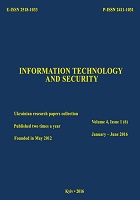High performance encryption tools of visual information based on cellular automata
DOI:
https://doi.org/10.20535/2411-1031.2016.4.1.96020Keywords:
Visual information, encryption, video, cellular automata, Field-Programmable Gate Array.Abstract
This article describes a method of encryption of visual information, based on the use of cellular automata. This method allows you to solve problems with noise errors in deciphering information, low-speed, low resistance to cracking, as well as move away from the use of generators of noise signals in the known methods of encryption of visual information. Analyzed modern encryption methods of visual information, as well as problems encountered in their implementation and use in the communication channels. The article also presents the structure of the device that implements - encryption is the visual information based on cellular automata, programs, texts, diagrams and results of the encryption method, the basic characteristics of the used field-programmable gate array. The essence of the method is to encrypt the visual information by overlaying additional transformations besides the usual encryption. The first additional conversion is carried out by the chosen method of encoding and digitizing images. The second transformation is to select the sequence of bit layers and their principles scan each block. Data conversions in the form of numerical values are used as additional fields to the key. In addition, the key is not given as a ready-bit sequence, but as the operation code, the units form a key sequence. Options propagation path of the excitation signal and a three-dimensional map of a cellular automaton states belong to the key sequence. The formation of pseudo-random key range increases reliability and protection to burglary resistance. Due to the three-dimensional image coding, the use of technologies of programmable integrated circuits and cellular automata increases speed encryption. The method allows you to create a key range implicitly, that reduces the probability of selecting an opponent. Encryption tools are implemented on cheap field-programmable gate array with high performance in speed, allowing you to encrypt visual information in real time during its transfer via communication channels.
References
“Encryption methods of video transmitted over the Internet”. [Online]. Available: http://eurocomplect.com/sposobyi-shifrovaniya-videoinformatsii-peredavaemoy-cherez-internet.php. Accessed on: Dec. 17, 2015.
L. Finkelstein, J. Kosmach, and J. Smolinske. “Method and apparatus for providing cryptographic protection of a data stream in a communication system”, US Patent Appl. EP 0671092 A1, Sept. 13, 1995.
S.V. Valov, A.Ia. Olkhovskii, O.A. Pavlov, Iu.F. Pakhomov, and V.G. Starodubtsev, “Speech signals encoding and decoding device”, RU Patent Appl. 2050698, Dec. 20, 1995.
Yu.B. Rytsar, M.P. Kozlovskyi, M.V. Shovheniuk, S.V. Voloshynovskyi, and Z.D. Hrytskiv, “The method of visual information securing”, UA Patent Appl. 22285, June 15, 2001.
A. Volodin, V. Mitko, and E. Spinko, “Video Encryption-Developer Workshop”. [Online]. Available: http://www.chipinfo.ru/literature/chipnews/200103/2.html. Accessed on: Dec. 17, 2015.
A.V. Iakovenko, V.V. Larin, and R.V. Tarnopolov, “Approaches for protection vydeoynformatsyy based on Elimination of redundancy in ynfokommunykatsyyah”, Modern special equipment, no. 2 (37), pp. 82-89, 2014.
I.L. Erosh, A.M. Sergeev, and G.P. Filatov, “Protection of images during transfer via communication channels”, Information and Control Systems, no. 5, pp. 20-22, 2007.
L.A. Mironovskii, and V.A. Slaev, Strip method of images and signals transformation. Saint Petersburg, Russia: Politekhnika, SPb, 2006.
L. Tang, “Methods for encrypting and decrypting MPEG video data efficiently”, in Proc. of the fourth ACM international conference on Multimedia, Boston, USA, 1996, pp. 219-229. doi: 10.1145/244130.244209.
H. Cheng, and X. Li, “On the Application of image Decomposition to Image Compression and Encryption”, in Proc. of the IFIP TC6/TC11 International Conference on Communications and Multimedia Security, Essen, Germany, 1996, pp. 116-127. doi: 10.1007/978-0-387-35083-7_11.
T. Kunkelmann, and U. Horn, “Partial Video Encryption based on Scalable Coding”, in Proc. 5th International Workshop on Systems, Signals and Image Processing, Zagreb, Croatia, 1998, pp. 215 – 218.
V.V. Mokhor, S.M. Bilan, and A.A. Demash, “The method of securing visual information”, UA Patent Appl. 99465, June. 10, 2015.
A.P. Antonov, AlteraHDL - Language of description digital devices. Practical course. Moskow, Russia: IP Radio-Soft, 2001.
V.B. Steshenko, ALTERA’s FPLD: developing of signal processing devices.Moskow, Russia: Dodeka XXI, 2000.
S.M. Bilan, Information security in telecommunication systems, Kyiv, Ukraine: DETUT, 2015.
Downloads
Published
How to Cite
Issue
Section
License
Copyright (c) 2020 Collection "Information technology and security"

This work is licensed under a Creative Commons Attribution 4.0 International License.
The authors that are published in this collection, agree to the following terms:
- The authors reserve the right to authorship of their work and pass the collection right of first publication this work is licensed under the Creative Commons Attribution License, which allows others to freely distribute the published work with the obligatory reference to the authors of the original work and the first publication of the work in this collection.
- The authors have the right to conclude an agreement on exclusive distribution of the work in the form in which it was published this anthology (for example, to place the work in a digital repository institution or to publish in the structure of the monograph), provided that references to the first publication of the work in this collection.
- Policy of the journal allows and encourages the placement of authors on the Internet (for example, in storage facilities or on personal web sites) the manuscript of the work, prior to the submission of the manuscript to the editor, and during its editorial processing, as it contributes to productive scientific discussion and positive effect on the efficiency and dynamics of citations of published work (see The Effect of Open Access).

